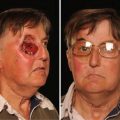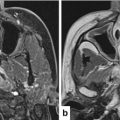Setting
Outcomes
Janot et al. [19]
GETTEC-GORTEC phase III trial
(NCT00180934)
n = 130 (65 each arm)
Resectable recurrent HNC
Sx + postoperative reRT (vs. Sx alone)
Total 60 Gy: 2 Gy/fraction, 5 days/week for 5 days, six cycles after 9 days rest
Conventional RT
Minimal FU: 2 years
PO reRT arm had a higher LRC but similar OS (8 % tx-related deaths)
Significantly more grade 3–4 late toxicity (39 % vs. 11 % at 2 years)
Five treatment-related deaths
Spencer et al. [21]
RTOG 9610 phase II trial
n = 79
Unresectable recurrent HNC
Definitive reRT (1.5 Gy per fraction bid x 5 days every 2 weeks x 4) + 5-FU/hydroxyurea
Conventional RT
Minimal FU: 5 years
2-year OS: 16.9 %
Late toxicity: grade 3: 19.4 %; grade 4: 3.0 %; grade 5: 0
Langer et al. [22]
RTOG 9911 phase II trial
(NCT00005087)
n = 105
Unresectable recurrent HNC
Definitive reRT (1.5 Gy per fraction bid x 5 days every 2 weeks x 4) + CDDP/paclitaxel/G-CSF
Conventional RT
Median FU: 23.6 months
2-year OS: 25.9 %
Late toxicities: grade 3: 16.9 %; grade 4: 16.9 %; grade 5: 3.6 %
Chen et al. [28]
Prospective trial
n = 21
Resectable or unresectable recurrent HNC or second primary
IMRT with daily IGRT (MV CT)
66 Gy (range, 60–70 Gy)
Postoperative RT: 11; definitive RT: 10
Median FU: 20 months
2-year OS: 40 %
2-year in-field control: 65 %
57 % had G-tube dependency at last FU
Cohen et al. [36]
Phase I trial
n = 25
Unresectable recurrent HNC
Conventional RT 72 Gy/42f (1.8 Gy/f for the first 54 Gy; 1.5 Gy/day boost after 32.4 Gy) + tirapazamine and cisplatin
2-year OS 27 %
One with grade 3 trismus and one with grade 3 otitis; one patient from each cohort experienced a fatal carotid hemorrhage.
Vargo et al. [37]
Phase II trial
n = 48
Unresectable recurrent HNC or in-field second primary
SBRT (40–44 Gy/5f/1–2 weeks) plus cetuximab
Median FU: 18 months
1-year OS: 40 %; 1-year LRC: 37 %
Grade 3 late toxicity: 6 %; no ≥ grade 4 toxicity
All three trials above reported significant late toxicities (Table 13.1). However, these trials all used conventional RT technique which may have contributed to inability to spare normal tissue. As well, reRT protocols in all three trials implemented planned treatment breaks between cycles which might have allowed tumor repopulation, thereby affecting treatment efficacy.
When selecting RT dose/fractionation, balancing the inconvenience of RT protraction versus the risk of late toxicity with short hypo-fractionation courses (e.g., stereotactic) needs to be considered. Although stereotactic radiosurgery (SRS) or stereotactic body irradiation (SBRT) is attractive option for reRT, the large fraction sizes employed are a concern for severe late toxicity. Owen et al. [23] reported long-term follow-up of stereotactic radiosurgery in 184 HNC patients, of whom 120 (65 %) were treated for recurrent HNC and detected late effects in 59 patients, the most common being temporal lobe necrosis (15 patients). From the radiobiology point of view, smaller fraction sizes are beneficial for protecting normal tissue from late toxicity [24]. Cvej et al. [25] reported relatively hyper-fractionated SBRT (48 Gy in 16 fractions, twice daily, 6 h apart) for 40 recurrent HNC patients treating recurrent gross tumor (GTV) with only a 3 mm margin for RT coverage without any prophylactic nodal volume. One-year OS and LC were 33 % and 44 %, respectively. Mandibular osteoradionecrosis occurred in four cases (10 %); however, neither carotid blowout syndrome nor other grade 4 late toxicity occurred. This supports a benefit for smaller fraction size in reducing late toxicities.
Consideration of reRT Technique
IMRT has shown promising possibilities in improving therapeutic ratio on the reRT setting. The potential advantages of IMRT include more conformal dose distribution to an irregularly shaped tumor resulting in less tumor under-dose, higher tumoricidal doses can be given due to normal tissue sparing, and more accurate RT delivery under daily image guidance. Target delineation is an important aspect in IMRT. reRT target volume definition has varied among institutions. Lee et al. [26] analyzed 105 recurrent HNC patients who underwent reRT, of whom 74 (70 %) were treated with IMRT. IMRT targets included GTV with 1.0–2.0 cm expansion for RT coverage without treating any subclinical volume. The 2-year LRC was 52 % for the IMRT cohort compared to 20 % in the non-IMRT cohort, a result confirmed in multivariable analysis for LRF (IMRT vs. non-IMRT HR 0.37, p = 0.006). Grade 3 or 4 late toxicities occurred in 12 (11 %) patients. Sher et al. [9] reported efficacy and toxicities of 35 recurrent HNC treated with IMRT with concurrent chemotherapy. The median RT dose was 67.5 Gy. The clinical target volume (CTV) included 1.0–1.5 cm expansion from GTV for RT tumor coverage and another 0.5 cm expansion for PTV. The 2-year OS and LRC rates were 48 % and 67 %, respectively, an improvement from historical data. However, approximately 46 % of patients developed at least one late grade 3 toxicity, and four (11 %) late deaths occurred in patients without evidence of disease (two aspiration events, one oropharyngeal hemorrhage, and one infectious death). The potential reason for the late toxicity might be the large RT margin used for CTV and PTV. Popovtzer et al. [27] reported patterns of failure of 66 patients (44 definitive reRT and 22 adjuvant reRT) after either 3D conformal or IMRT with recurrent GTV (rGTV) plus a 0.5 cm margin for RT coverage without an additional prophylactive nodal volume or coverage for subclinical disease in the vicinity of the rGTVs and found 45/47 LRF were in-field and only two (4 %) LRF were out-of-field. The 2-year OS was 45 %, suggesting that tighter margins without a prophylactive volume seem reasonable. Chen et al. [28] conducted an institutional prospective trial of 21 patients for IMRT with daily IGRT (MV CT) using tight CTV and PTV margin design. The CTV was a 0.5 cm expansion from GTV, and the PTV was a 0.3 cm expansion from CTV. The 2-year OS was 40 %, and the 2-year in-field control was 65 %. Toxicity seemed acceptable. There were no treatment-related fatalities or hospitalizations. Curtis et al. [29] reported the reRT outcome of 81 patients treated at the Mayo clinic, of whom 77 (95 %) received IMRT but the margin of the target volume was not described. Two-year LRC was 60 %, and 2-year OS was 53 % for adjuvant reRT and 48 % for definitive reRT. Late serious toxicity was uncommon but included osteoradionecrosis (two patients) and carotid artery bleeding (one patient, nonfatal).
Proton therapy offers theoretical advantages for normal tissue protection for reRT owing to its sharper dose falloff characterized by the Bragg peak. The clinical evidence for its role is emerging. Romesser et al. [30] reported early promising result of proton reRT for 85 oropharyngeal cancer patients (39 % postoperative reRT and 61 % definitive reRT). With a median follow-up of 13 months, the 1-year LRC was 75 % and 1-year OS was 65 %. Grade 3 or greater late skin and dysphagia toxicities were noted in six patients (8.7 %) and four patients (7.1 %), respectively. Two patients had grade 5 toxicity due to treatment-related bleeding. However, longer follow-up is needed to make any final deductions.
Brachytherapy, essentially the most sparing and traditional form of local RT delivery process available, is a plausible modality for use in reRT protocols. It delivers radiotherapy by positioning radioactive sources in direct proximity to the tumor target area. The advantage of brachytherapy is its highly conformal dose distribution to a small target area by virtue of a rapid “falloff” within surrounding normal tissues. It can be used alone or after surgery and as a local boost in combination with external-beam radiation therapy for salvage of small recurrences. No randomized trials have been performed comparing brachytherapy versus other conventional treatment in HNC. The 2-year OS rates for reRT with brachytherapy approaches from retrospective series vary from 17 to 71 % [31]. The large variation in results is potentially a consequence of cohort heterogeneity and case selection in reported series.
An exploratory brachytherapy approach for recurrence is intraoperative radiotherapy (IORT). IORT delivers radiation directly to the tumor bed immediately following surgical resection. The hypothetical advantages of IORT are its capability to deliver high single fraction doses to a specific target with high precision, thus protect surrounding normal tissue and faster treatment times between surgery and adjuvant reirradiation. The latter may combat the deleterious influence of tumor cell proliferation during the overall management duration and potentially make the best use of the residual vascularized condition of tissues immediately following surgery to maximize tumor control [32]. It is often combined selectively with external-beam RT and concurrent or induction systemic approaches. Several institutions have reported institutional experience in highly selected cases [33–35] (Table 13.2). However, this approach requires local expertise and very close cooperation between surgical and radiation teams, in addition to significant functional and rehabilitation support. Currently it remains investigational within centers with expertise in these approaches.
Table 13.2
Outcome of intraoperative reirradiation for recurrent HNC
Techie et al. [34] (MSKCC, New York) | Scala et al. [33] (Beth Israel) | Chen et al. [35] UCSF | |
|---|---|---|---|
Cohort | N = 57, 1998–2011 IORT 15 Gy (12–20) | N = 76, 2001–2010 IORT: 12 Gy for margin (−); 15–17.5 Gy for margin (+) | N = 137, 1991–2007 IORT: 15 Gy (10–18) |
Median FU | 16 m (1.3 years) | 11 m (0.9 years) | 41 m (3.4 years) |
OS
Stay updated, free articles. Join our Telegram channel
Full access? Get Clinical Tree
 Get Clinical Tree app for offline access
Get Clinical Tree app for offline access

|



